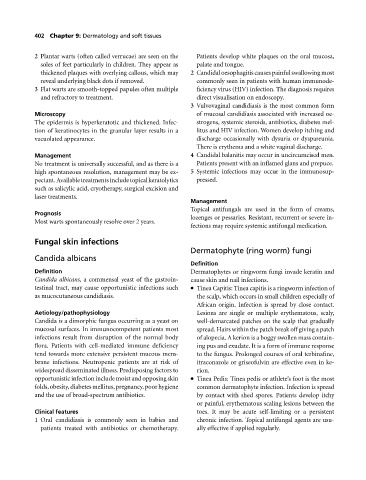Page 406 - Medicine and Surgery
P. 406
P1: FAW
BLUK007-09 BLUK007-Kendall May 12, 2005 19:59 Char Count= 0
402 Chapter 9: Dermatology and soft tissues
2 Plantar warts (often called verrucae) are seen on the Patients develop white plaques on the oral mucosa,
soles of feet particularly in children. They appear as palate and tongue.
thickened plaques with overlying callous, which may 2 Candidaloesophagitiscausespainfulswallowingmost
reveal underlying black dots if removed. commonly seen in patients with human immunode-
3 Flat warts are smooth-topped papules often multiple ficiency virus (HIV) infection. The diagnosis requires
and refractory to treatment. direct visualisation on endoscopy.
3 Vulvovaginal candidiasis is the most common form
Microscopy of mucosal candidiasis associated with increased oe-
The epidermis is hyperkeratotic and thickened. Infec- strogens, systemic steroids, antibiotics, diabetes mel-
tion of keratinocytes in the granular layer results in a litus and HIV infection. Women develop itching and
vacuolated appearance. discharge occasionally with dysuria or dyspareunia.
There is erythema and a white vaginal discharge.
Management 4 Candidal balanitis may occur in uncircumcised men.
No treatment is universally successful, and as there is a Patients present with an inflamed glans and prepuce.
high spontaneous resolution, management may be ex- 5 Systemic infections may occur in the immunosup-
pectant.Availabletreatmentsincludetopicalkeratolytics pressed.
such as salicylic acid, cryotherapy, surgical excision and
laser treatments.
Management
Topical antifungals are used in the form of creams,
Prognosis
lozenges or pessaries. Resistant, recurrent or severe in-
Most warts spontaneously resolve over 2 years.
fections may require systemic antifungal medication.
Fungal skin infections
Dermatophyte (ring worm) fungi
Candida albicans
Definition
Definition Dermatophytes or ringworm fungi invade keratin and
Candida albicans,acommensal yeast of the gastroin- cause skin and nail infections.
testinal tract, may cause opportunistic infections such Tinea Capitis: Tinea capitis is a ringworm infection of
as mucocutaneous candidiasis. the scalp, which occurs in small children especially of
African origin. Infection is spread by close contact.
Aetiology/pathophysiology Lesions are single or multiple erythematous, scaly,
Candida is a dimorphic fungus occurring as a yeast on well-demarcated patches on the scalp that gradually
mucosal surfaces. In immunocompetent patients most spread. Hairs within the patch break off giving a patch
infections result from disruption of the normal body of alopecia. A kerion is a boggy swollen mass contain-
flora. Patients with cell-mediated immune deficiency ing pus and exudate. It is a form of immune response
tend towards more extensive persistent mucous mem- to the fungus. Prolonged courses of oral terbinafine,
brane infections. Neutropenic patients are at risk of itraconazole or griseofulvin are effective even in ke-
widespread disseminated illness. Predisposing factors to rion.
opportunistic infection include moist and opposing skin Tinea Pedis: Tinea pedis or athlete’s foot is the most
folds,obesity,diabetesmellitus,pregnancy,poorhygiene common dermatophyte infection. Infection is spread
and the use of broad-spectrum antibiotics. by contact with shed spores. Patients develop itchy
or painful, erythematous scaling lesions between the
Clinical features toes. It may be acute self-limiting or a persistent
1 Oral candidiasis is commonly seen in babies and chronic infection. Topical antifungal agents are usu-
patients treated with antibiotics or chemotherapy. ally effective if applied regularly.

